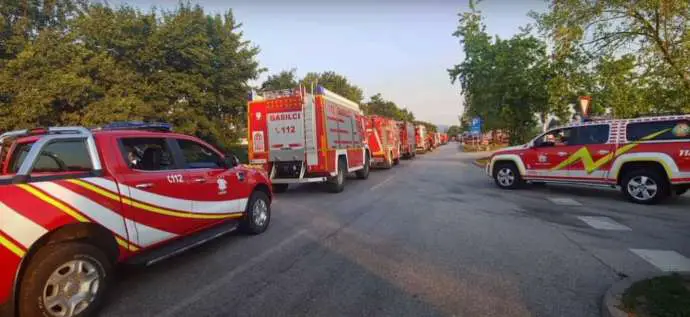STA, 22 July - People from three villages in the Kras region in the west are being evacuated as the wind changed direction on Friday in what is the third evacuation of local population this week. This time, the situation is critical in Opatje Selo, Nova Vas and Hudi Log. Journalists must also leave the villages.
Almost 1,000 firefighters and 300 other members of disaster relief services keep battling the huge blaze in the region, along with 130 foresters, who are cutting down trees to stop the fire. More than 2,000 hectares of land has been affected by the fire.
Defence Minister Marjan Šarec is at the site for the third day running. He said the situation was still very serious. Firefighters are doing their best to prevent the fire from crossing the roads to Trstelj and are also defending a building near Opatje Selo.
The danger of unexploded ordnance from the First World War remains an issue. Today a shrapnel from the ordnance that exploded due to the heat flew by the firefighters who were in the vicinity but luckily no one was hurt.
"The problem is that because of the unexploded ordnance firefighting units cannot penetrate into the fire but can only act on its edges. This is why the fire is being intensively fought from the air as well," Šarec said.
Below: The location of Opatje Selo, one of the affected villagesTwo Slovenian helicopters and a military aircraft are engaged in these efforts along with helicopters from Slovakia, Austria and two from Serbia, Two more expected from Hungary.
The minister had no information on whether a water bomber from any of the neighbouring countries would again be able to help today or not.
Interior Minister Tatjana Bobnar and acting Police Commissioner Boštjan Lindav arrived at the site today, and PM Robert Golob is expected.
Bobnar told the press that the state will purchase a new helicopter that will be intended for fire-fighting, and also for emergency medical and mountain rescue.
Arriving in Kostanjevica na Krasu, she expressed "moral support, admiration and all other support" to all those battling the blaze, adding that the government would do everything in its power to help them.
The Slovenian firefighters' association has launched a fund-raising campaign for the firefighters. Those who wish to help can send an SMS with the word GSILEC5 to 1919 and donate 5 euro or transfer money to a special account TRR SI56 0400 1004 6481 225.
The fire is also being monitored by the EU Copernicus system, designed to monitor the Earth and run by the European Commission and the European Union Agency for the Space Programme in cooperation with the European Space Agency and EU countries.
Copernicus has been monitoring the fire since Thursday at the request of the Administration for Civil Protection and Disaster Relief. The situation can be monitored at here.
Forest restoration is expected to be challenging.
Branka Gašparič, the head of the Sežana unit of the Forest Institute, told the STA efforts had been made for years to create roads and areas preventing the spread of fires, which are frequent in the region.
Now, as villages are being defended from the blaze, people have been cutting trees, expanding these areas to prevent the fire from expanding further, she said.
The most problematic species in Kras in terms of fires is black pine because of its resin and etheric oils. But the species has also proven to be the most appropriate for forest restoration, so it will be used for this purpose now as well to help vegetation recover quicker, Gašperič said.
Black pines will be the foundation in reforestation, followed by oak trees and other species adjusted to heat. Some parts of the land affected by the fire will be left to recover on their own, she said.
Kras used to be covered in forests, but after cutting of forests started the region was virtually devoid of trees in the early 19th century. Several waves of reforestation followed and around 1850 reforestation companies were being founded. Yet first attempts at planting deciduous trees were not particularly successful.
It was only in the 19th century as black pine gained prominence and appropriate legislation was put in place that forests started growing again in Kras. Between 1945 and 154, the efforts brought notable results and around 4,000 hectares of land was turned into forests again.






